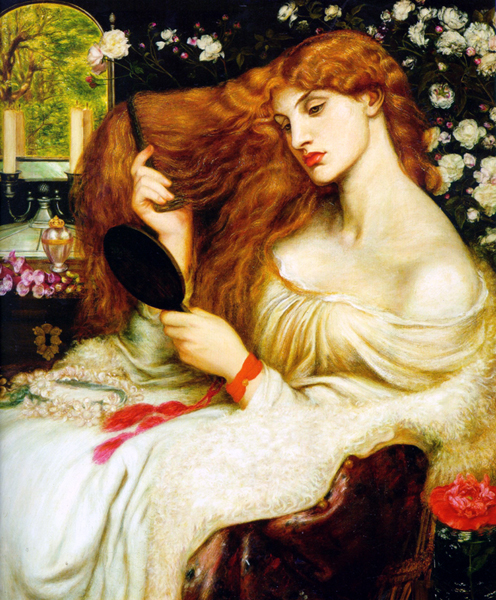
And her enchanted hair was the first gold./And still she sits, young while the earth is old –from Dante Gabriel Rossetti’s sonnet Lady Lilith
Lilith appears here with pale skin and clad in a white gown, making her luxurious hair the most vivid thing in the room. In this painting, Dante Gabriel Rossetti is not showing us a simple image of a beautiful woman. He’s giving us Lilith, the first woman, the witch, the goddess. Her face seems strangely passive as she looks at her own reflection, until we read Rossetti’s sonnet and understand that even while she gazes at herself she is fully capable of tearing you apart: And,subtly of herself contemplative/Draws men to watch the bright web she can weave/Till heart and body and life are in its hold. Look at the mirror that hangs on her wall and you will see that all is not right here. Where the room should be reflected, we glimpse an enchanted world. Beware Lilith and her enchanted tresses before you fall under her spell.
Rossetti created a similar work in his 1864 Woman combing her hair, except this time there is no sonnet or title to warn us of her intent. Instead of gazing at herself, her thoughts appear elsewhere. This time, the mirror on the wall performs its proper and mundane function so that we can see the room’s reflection. There is no threat here. These tresses are merely pretty, not enchanted. Although, you could still fall under her spell.
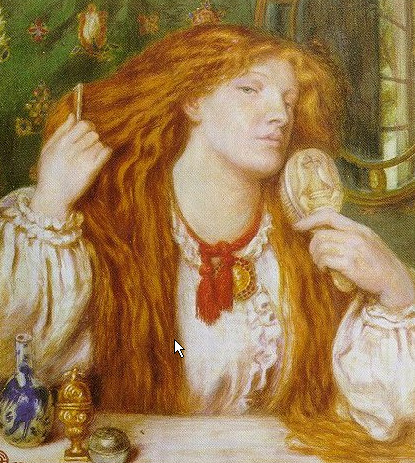
It is impossible not to notice similarities between Lady Lilith and Woman combing her hair with Fazio’s Mistress (Aurelia).
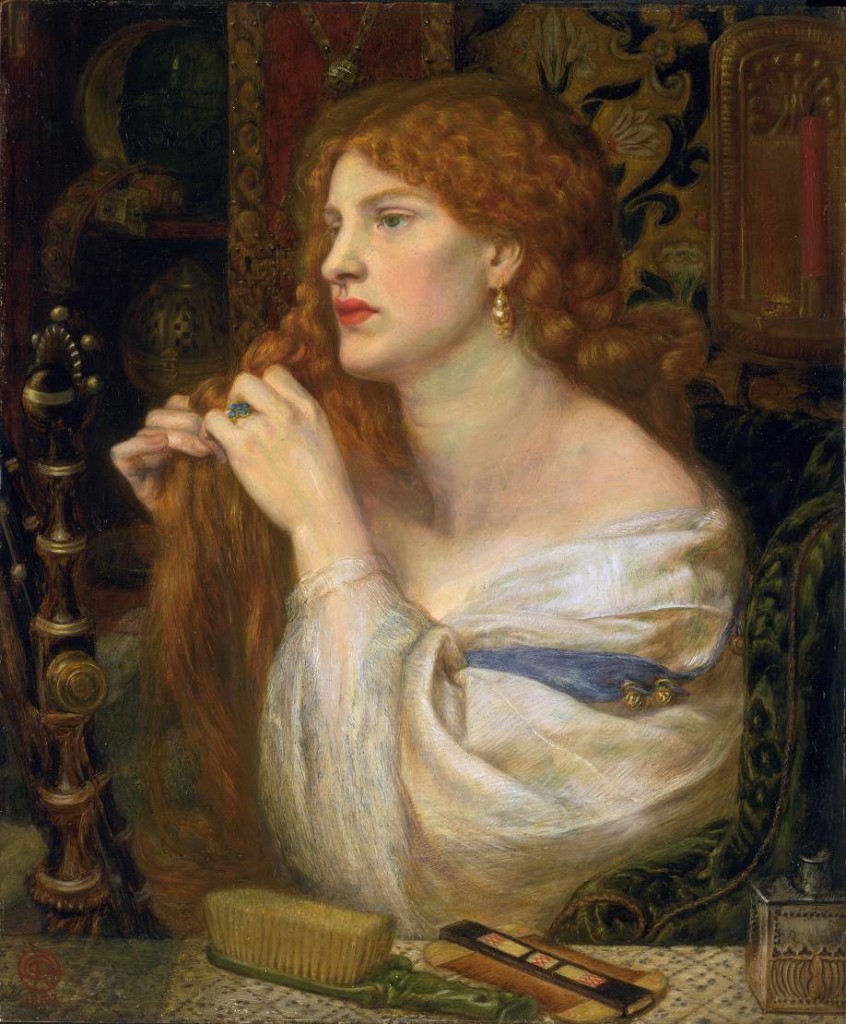
Hair figures strongly in many of Rossetti’s works and is important symbolically in many Pre-Raphaelite pieces. The Victorians attached great importance to hair and only children would normally be seen with theirs unbound. Married women would not wear their hair down in the presence of men other than their husband.
It has been said that when model Elizabeth Siddal posed for Rossetti as Delia, he began to develop feelings for her when she happily took her hair down to get into character. How ironic that hair should be mentioned at the impetus of their relationship. A decade later they would marry, with their marriage cut short by her overdose of Laudanum. Seven years later when he had her coffin exhumed to retrieve poems he had buried with her, the false and strange rumor spread that her famous hair had continued to grow after death.

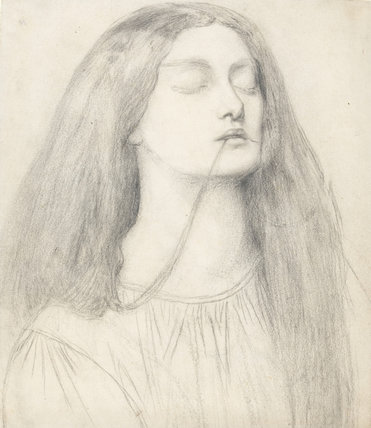
Another example of ‘enchanted’ hair is William Holman Hunt’s The Lady of Shalott. Many Pre-Raphaelite artists painted the Lady of Shalott, some of them repeatedly. But only Holman Hunt depicted her hair whipping wildly, perhaps by supernatural means, when the Lady has fallen in love with a vision of Lancelot and decides to ignore the curse that has come upon her.
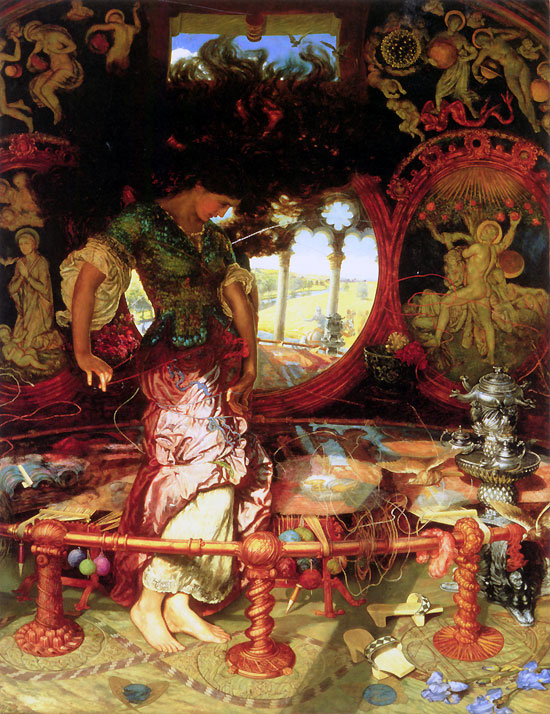

Isabella and the pot of basil is another supernatural yet gruesome tale in which hair is used symbolically. Based on the poem by Keats, Isabella’s lover was murdered by her brothers. His ghost later appears to Isabella and he leads her to his buried body. She digs him up, removes his head and buries it in a pot of basil. She then cares for the pot of basil obsessively, pining away and consumed with grief. She is seen here, in William Holman Hunt’s painting, her hair mingling with the leaves of the basil plant. (Also see Love, Death, and Potted Plants)
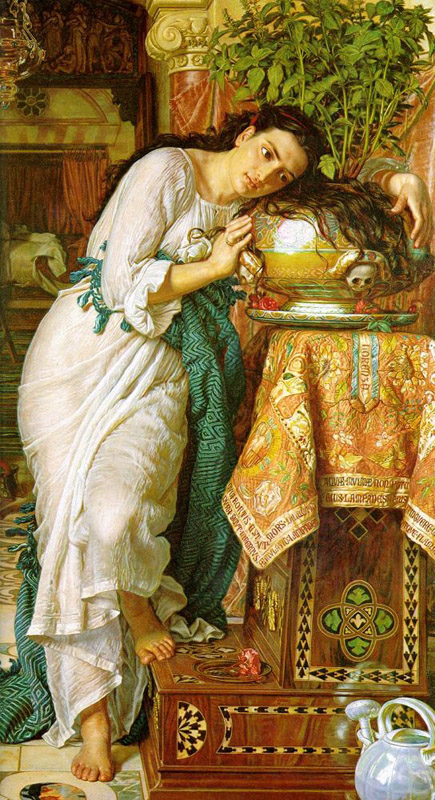
Victorian hair was meant to be up, put away, private. When I see images such as these it strikes me that there is this sense that, like Samson, perhaps a woman’s hair was a source of power. To have it free was to resist boundaries and rules. Years later, women would take their hair into their own hands, drastically cutting it into the bobbed and shingled styles of the 1920s. Now, we’ve become the complete opposite of the Victorians and our society seems surprised when we see a woman over 35 or 40 who dares to keep her hair long. I say wear your hair however you think it suits you, regardless of societal norms.
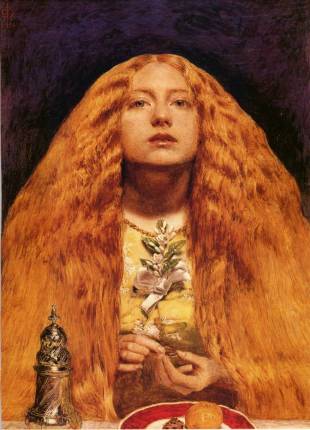
No one but a pre-Raphaelite would have painted, hair by hair, those feathery masses of ringlets with every glimmer of gold, and every shadow of pale brown. No one but a pre-Raphaelite would have so exaggerated every attribute of that delicate face as to give a lurid lightness to the blonde complexion, and a strange, sinister light to the deep blue eyes. No one but a pre-Raphaelite could have given to that pretty pouting mouth the hard and almost wicked look it had in the portrait.–Mary Elizabeth Braddon, Lady Audley’s Secret
Also see:
The Beautiful Necessity: Pre-Raphaelite Tresses

Nice post, as usual, Stephanie. Thank-you. I suppose there’s an equation here between abundant hair, worn loose, and female sexuality. Many men (including Rossetti, I think, certainly including Burne-Jones) will find that attractive and frightening in equal measure.
Thanks for a fascinating post! Holman Hunt’s painting is not my favourite depiction of the Lady of Shalott (I find it too fussy, too much detail, I much prefer Waterhouse’s depictions). Apparently, he spent about 20 years working on the amazing hair which unfortunately you can’t see very clearly in the images on the web.
Hair in Victorian era was an important part of woman’s beauty. There is plenty of photos of Victorian girlwith extremely long hair – and don’t forget about famous hair of Sissi (Elisabeth Empress of Austria).